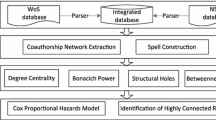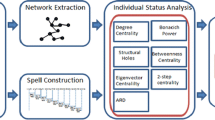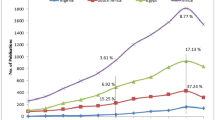Abstract
This paper aims to assess the diffusion and adoption of nanotechnology knowledge within the Turkish scientific community using social network analysis and bibliometrics. We retrieved a total of 10,062 records of nanotechnology papers authored by Turkish researchers between 2000 and 2011 from Web of Science and divided the data set into two 6-year periods. We analyzed the most prolific and collaborative authors and universities on individual, institutional and international levels based on their network properties (e.g., centrality) as well as the nanotechnology research topics studied most often by the Turkish researchers. We used co-word analysis and mapping to identify the major nanotechnology research fields in Turkey on the basis of the co-occurrence of words in the titles of papers. We found that nanotechnology research and development in Turkey is on the rise and its diffusion and adoption have increased tremendously thanks to the Turkish government’s decision a decade ago identifying nanotechnology as a strategic field and providing constant support since then. Turkish researchers tend to collaborate within their own groups or universities and the overall connectedness of the network is thus low. Their publication and collaboration patterns conform to Lotka’s law. They work mainly on nanotechnology applications in Materials Sciences, Chemistry and Physics, among others. This is commensurate, more or less, with the global trends in nanotechnology research and development.







Similar content being viewed by others
Notes
Search on WoS was carried out on January 11, 2015.
Personal communication with Prof. Ronald N. Kostoff (20 April 2012).
We used the command “AD = TURKEY” that is available in WoS.
Available from http://www.gpsvisualizer.com/geocoder/.
More detailed findings of the latent semantic analysis used in this research are reported elsewhere (Darvish 2014).
The co-word analysis was conducted based on software:http://www.leydesdorff.net/software/fulltext/index.htm.
References
Aydogan-Duda, N. (2012). Nanotechnology: A descriptive account. Making it to the forefront in Aydogan-Duda, N. (Ed). Nanotechnology: A developing country perspective (pp. 1–4). New York: Springer.
Aydogan-Duda, N., & Şener, I. (2010). Entry barriers to the nanotechnology industry in Turkey. In N. Ekekwe (Ed.), Nanotechnology and microelectronics: Global diffusion, economics and policy (pp. 167–173). Hershey, PA: IGI Global.
Barabasi, A. L., & Albert, R. (1999). Emergence of scaling in random networks. Science Magazine, 286(5439), 509–512.
Börner, K., Sanyal, S., & Vespignani, A. (2007). Network science. Annual Review of Information Science and Technology, 41(1), 537–607.
Bozkurt, A. (2015). Türkiye, 10 yıldır “en küçük” dünyanın farkında, artık büyük adımlar atması gerekiyor (Turkey is aware of the “smallest” world for 10 years, but it should take big steps). Bilişim: Aylık Bilişim Kültürü Dergisi, 43(172), 44–53. Retrieved June 6, 2015, from http://www.bilisimdergisi.org/s172/pages/s172_web.pdf.
Braun, T., Schubert, A., & Zsindely, S. (1997). Nanoscience and nanotechnology on the balance. Scientometrics, 38(2), 321–325.
Callon, M., Courtial, J. P., Turner, W. A., & Bauin, S. (1983). From translations to problematic networks: An introduction to co-word analysis. Social Science Information, 22(2), 191–235.
Centrality. (2015). Retrieved, January 20, 2015, from http://en.wikipedia.org/wiki/Centrality.
Chen, C. (2004). Searching for intellectual turning points: Progressive knowledge domain visualization. PNAS, 101(Suppl. 1), 5303–5310.
Chen, C. (2006) CiteSpace II: Detecting and visualizing emerging trends and transient patterns in scientific literature. Journal of the American Society for Information Science and Technology, 57, 359–377.
Chen, C., Chen, Y., Horowitz, M., Hou, H., Liu, Z., & Pellegrino, D. (2009). Towards an explanatory and computational theory of scientific discovery. Journal of Informetrics, 3(3), 191–209.
Darvish, H. (2014). Assessing the diffusion of nanotechnology in Turkey: A social network analysis approach. Unpublished PhD dissertation. Hacettepe University, Ankara.
Darvish, H. R., & Tonta, Y. (2015a). The diffusion of nanotechnology knowledge in Turkey. In A. A. Salah, et al. (Eds.), Proceedings of ISSI 2015 Istanbul: 15th International society of scientometrics and informetrics conference, Istanbul, Turkey, 29 June–4 July, 2015 (pp. 720–731). İstanbul: Boğaziçi University.
Darvish, H. R., & Tonta, Y. (2015b). The network structure of nanotechnology research output of Turkey: A co-authorship and co-word analysis study. In A. A. Salah, et al. (Eds.), Proceedings of ISSI 2015 Istanbul: 15th International society of scientometrics and informetrics conference, Istanbul, Turkey, 29 June–4 July, 2015 (pp. 732–743). İstanbul: Boğaziçi University.
Denkbaş, E. B. (2015). Nanoteknolojiye yapılacak yatırımlar, ülkelerin ekonomik gücünü yansıtabilecek bir parametre olacak (Investments in nanotechnology will become a parameter reflecting economic powers of countries). Bilişim: Aylık Bilim Kültürü Dergisi, 43(172), 78–87. Retrieved June 6, 2015, from www.bilisimdergisi.org/pdfindir/s172/pdf/78-87.pdf.
Erkoç, Ş. (2007). Nanobilim ve Nanoteknoloji (nanoscience and nanotechnology). Ankara: ODTÜ Geliştirme Vakfı.
Freeman, L. C. (2004). The development of social network analysis: A study in the sociology of science. Vancouver: Empirical Press.
Günay, D., & Günay, A. (2011). 1933’den günümüze Türk yükseköğretiminde niceliksel gelişmeler (Quantitative developments in Turkish higher education since 1933). Yükseköğretim ve Bilim Dergisi, 1(1), 1–22. doi:10.5961/jhes.2011.001. Retrieved, December 1, 2015, from http://higheredu-sci.beun.edu.tr/pdf/pdf_HIG_1517.pdf.
Hou, H., Kretschmer, H., & Liu, Z. (2008). The structure of scientific collaboration networks in scientometrics. Scientometrics, 75(2), 192–201.
Kostoff, R. N., Koytcheff, R. G., & Lau, C. G. Y. (2007). Global nanotechnology research literature overview. Technological Forecasting and Social Change, 74, 1733–1747.
Kostoff, R. N., Stump, J. A., Johnson, D., Murday, J. S., Lau, C. G. Y., & Tolls, W. M. (2006). The structure and infrastructure of global nanotechnology literature. Journal of Nanoparticles Research, 8, 301–321.
Landauer, T. K., Foltz, P. W., & Laham, D. (1998). Introduction to latent semantic analysis. Discourse Processes, 25, 259–284.
Leydesdorff, L., & Welbers, K. (2011). The semantic mapping of words and co-words in contexts. Journal of Informetrics, 5(3), 469–475.
Mali, F., Kronegger, L., Doreian, P., & Ferligoj, A. (2012). Dynamic scientific co-authorship networks. In A. Scharnhorst, K. Börner, & P. Van den Besselaar (Eds.), Models of science dynamics—Encounters between complexity theory and information sciences (pp. 195–232). Berlin: Springer.
Martin, T., Ball, B., Karrer, B., & Newman M. E. J. (2013). Coauthorship and citation in scientific publishing. Retrieved December 27, 2014, from http://arxiv.org/abs/1304.0473.
Milgram, S. (1967). The small world problem. Psychology Today, 1(1), 61–67.
Milojević, S. (2009). Big science, nano science? Mapping the evolution and socio-cognitive structure of nanoscience/nanotechnology using mixed methods. Unpublished PhD Dissertation, University of California, Los Angeles.
Milojević, S. (2012). Multidisciplinary cognitive content of nanoscience and nanotechnology. Journal of Nanoparticle Research, 14(1), 1–28.
Moody, J. (2004). The structure of a social science collaboration network: Disciplinary cohesion from 1963 to 1999. American Sociological Review, 69(2), 213–238.
Nanobilim. (2004). Nanobilim ve Nanoteknoloji Stratejileri (Nanoscience and Nanotechnology Strategies). Ankara: TÜBİTAK. Retrieved, December 2, 2015, from http://www.nanoturk.com/raporlar/vizyon2023_nano.pdf.
Nanotechnology. (2015). Retrieved, January 20, 2015, from http://en.wikipedia.org/wiki/Centrality.
Newman, M. E. J. (2001). The structure of scientific collaboration networks. PNAS, 98(2), 404–409.
Otte, E., & Rousseau, R. (2002). Social network analysis: A powerful strategy, also for the information sciences. Journal of Information Science, 28(6), 443–455.
Ovalle-Perandones, M.-A., Gorraiz, J., Wieland, M., Gumpenberger, C., & Olmeda-Gomez, G. (2013). The influence of European framework programmes on scientific collaboration in nanotechnology. Scientometrics, 97(1), 59–74.
Özel, B. (2010). Scientific collaboration networks: Knowledge diffusion and fragmentation in Turkish management academia. Unpublished PhD dissertation, Bilgi University, Istanbul.
Özgüz, V. (2013). Nanotechnology research and education in Turkey (presentation slides). Retrieved, December 27, 2014, from ttp://rp7.ffg.at/upload/medialibrary/12_Oezguez.pdf.
Page, L., & Brin, S. (1998). The anatomy of a large-scale hypertextual web search engine. Computer Networks and ISDN Systems, 30, 107–117.
Persson, O., Danell, R., & Wiborg Schneider, J. (2009). How to use Bibexcel for various types of bibliometric analysis. In F. Åström, R. Danell, B. Larsen, & J. Schneider (Eds.), Celebrating scholarly communication studies: A Festschrift for Olle Persson at his 60th birthday (pp. 9–24). Leuven: International Society for Scientometrics and Informetrics.
Rogers, E. M. (1962). Diffusion of innovations (1st ed.). New York: Free Press of Glencoe.
Rogers, E. M. (2003). Diffusion of innovations (5th ed.). New York: The Free Press.
Rousseau, R. (1997). Sitations: An exploratory study. Cybermetrics. Retrieved, February 14 2014, from http://cybermetrics.cindoc.csic.es/articles/v4i1p4.pdf.
Scharnhorst, A., & Garfield, E. (2010). Tracing scientific influence. Dynamics of Socio-Economic Systems, 2(1), 1–33.
Schummer, J. (2004). Multidisciplinarity, interdisciplinarity, and patterns of research collaboration in nanoscience and nanotechnology. Scientometrics, 59, 425–465.
Scott, J. (2000). Social network analysis: A handbook (2nd ed.). London: Sage.
Sonnenwald, D. H. (2007). Scientific collaboration. Annual Review of Information Science and Technology, 41, 643–681.
Testa, J. (2004). The Thomson Scientific journal selection process. Retrieved, November 25 2015 from http://scientific.thomson.com/free/essays/selectionofmaterial/journalselection/.
Ulusal. (2004). Ulusal Bilim ve Teknoloji Politikaları 2003–2023 Strateji Belgesi (National Science and Technology Policies The Strategi Document of 2003–2023. Ankara: TÜBİTAK. Retrieved, December 2, 2015, from http://www.tubitak.gov.tr/tubitak_content_files/vizyon2023/Vizyon2023_Strateji_Belgesi.pdf.
Van Eck, N. J., & Waltman, L. (2010). Software survey: VOSviewer, a computer program for bibliometric mapping. Scientometrics, 84, 523–538.
Vitanov, N. K., & Ausloos, M. R. (2012). Knowledge epidemics and population dynamics models for describing idea diffusion. In A. Scharnhorst, K. Börner, & P. Van den Besselaar (Eds.), Models of science dynamics—Encounters between complexity theory and information sciences (pp. 69–125). Berlin: Springer.
Watts, D. (2003). Six degrees: The science of a connected age. New York: Norton & Co.
White, H. D., & McCain, K. W. (1998). Visualizing a discipline: An author co-citation analysis of information science, 1972–1995. Journal of the American Society for Information Science, 49, 327–355.
Acknowledgments
We thank the anonymous reviewers for their detailed and constructive comments, which helped us improve the paper. Remaining errors are of course our own.
Author information
Authors and Affiliations
Corresponding author
Appendix: Query used to search Thomson Reuters’ Web of Science database
Appendix: Query used to search Thomson Reuters’ Web of Science database
In this “Appendix”, 9 queries are listed. The last one (#9) is the union of all the preceding ones.
-
#1.
TS = (NANOPARTICLE* OR NANOTUB* OR NANOSTRUCTURE* OR NANOCOMPOSITE* OR NANO-COMPOSITE* OR NANOWIRE* OR NANOCRYSTAL* OR NANOFIBER* OR NANOFIBRE* OR NANOSPHERE* OR NANOROD* OR NANOTECHNOLOG* OR NANOCLUSTER* OR NANOCAPSULE* OR NANOMATERIAL* OR NANOFABRICAT* OR NANOPOR* OR NANOPARTICULATE* OR NANOPHASE OR NANOPOWDER* OR NANOLITHOGRAPHY OR NANO-PARTICLE* OR NANODEVICE* OR NANODOT* OR NANOINDENT* OR NANO-INDENT* OR NANOLAYER* OR NANOSCIENCE OR NANOSIZE* OR NANO-SIZE* OR NANOSCALE* OR NANO-SCALE* OR NANOROBOT*) AND AD = (TURKEY) NOT TS = (NANOMET* OR NANO2 OR NANO3 OR NANO4 OR NANO5 OR NANOSEC* OR NANOSECOND* OR NANOMETERSCALE* OR NANOMETER LENGTH*)
-
#2.
TS = ((NM OR NANOMETER* OR NANOMETRE*) SAME (SURFACE* OR FILM* OR GRAIN* OR POWDER* OR SILICON OR DEPOSITION OR LAYER* OR DEVICE* OR CLUSTER* OR CRYSTAL* OR MATERIAL* OR SUBSTRATE* OR STRUCTURE* OR ROUGHNESS OR MONOLAYER* OR RESOLUTION OR PARTICLE* OR ATOMICFORCE MICROSCOP* OR TRANSMISSION ELECTRON MICROSCOP* OR SCANNING TUNNELING MICROSCOP*)) AND AD = (TURKEY) NOT TS = (NANOMET* OR NANO2 OR NANO3 OR NANO4 OR NANO5 OR NANOSEC* OR NANOSECOND* OR NANOMETERSCALE* OR NANOMETER LENGTH*)
-
#3.
TS = (nano*) AND SO = ((BULK “AND” GRADED NANOMETALS OR CURRENT NANOSCIENCE OR FROM NANOPOWDERS TO FUNCTIONAL MATERIALS OR FULLERENES NANOTUBES “AND” CARBON NANOSTRUCTURES OR FULLERENES NANOTUBES “AND” CARBON NANOSTRUCTURES OR FUNCTIONAL MOLECULAR NANOSTRUCTURES OR IEEE TRANSACTIONS ON NANOBIOSCIENCE OR IEEE TRANSACTIONS ON NANOTECHNOLOGY OR INORGANIC POLYMERIC NANOCOMPOSITES “AND” MEMBRANES OR JOURNAL OF COMPUTATIONAL “AND” THEORETICAL NANOSCIENCE OR JOURNAL OF NANOPARTICLE RESEARCH OR JOURNAL OF NANOSCIENCE “AND” NANOTECHNOLOGY OR MICROSYSTEM TECHNOLOGIES MICRO “AND” NANOSYSTEMS INFORMATION STORAGE “AND” PROCESSING SYSTEMS OR NANO LETTERS OR NANOPOROUS MATERIALS IV OR NANOTECHNOLOGY OR ON THE CONVERGENCE OF BIO INFORMATION ENVIRONMENTAL ENERGY SPACE “AND” NANO TECHNOLOGIES PTS 1 “AND” 2 OR PHYSICA E LOW DIMENSIONAL SYSTEMS NANOSTRUCTURES OR PRECISION ENGINEERING JOURNAL OF THE INTERNATIONAL SOCIETIES FOR PRECISION ENGINEERING “AND” NANOTECHNOLOGY OR SYNTHESIS “AND” REACTIVITY IN INORGANIC METAL ORGANIC “AND” NANO METAL CHEMISTRY OR JOURNAL OF NANOSCIENCE AND NANOTECHNOLOGY OR NANOTECHNOLOGY OR ACS NANO OR NANO LETTERS OR JOURNAL OF NANOPARTICLE RESEARCH OR NANOSCALE OR NANOSCALE RESEARCH LETTERS OR SMALL OR PHYSICA E LOW DIMENSIONAL SYSTEMS NANOSTRUCTURES OR INTERNATIONAL JOURNAL OF NANOMEDICINE OR JOURNAL OF COMPUTATIONAL AND THEORETICAL NANOSCIENCE OR JOURNAL OF NANOMATERIALS OR MICRO NANO LETTERS OR MICROSYSTEM TECHNOLOGIES MICRO AND NANOSYSTEMS INFORMATION STORAGE AND PROCESSING SYSTEMS OR IEEE TRANSACTIONS ON NANOTECHNOLOGY OR JOURNAL OF BIOMEDICAL NANOTECHNOLOGY OR SYNTHESIS AND REACTIVITY IN INORGANIC METAL ORGANIC AND NANO METAL CHEMISTRY OR NANO RESEARCH OR DIGEST JOURNAL OF NANOMATERIALS AND BIOSTRUCTURES OR NATURE NANOTECHNOLOGY OR NANOMEDICINE OR NANOMEDICINE NANOTECHNOLOGY BIOLOGY AND MEDICINE OR NANOSCIENCE AND NANOTECHNOLOGY LETTERS OR MICROFLUIDICS AND NANOFLUIDICS OR PRECISION ENGINEERING JOURNAL OF THE INTERNATIONAL SOCIETIES FOR PRECISION ENGINEERING AND NANOTECHNOLOGY OR CURRENT NANOSCIENCE OR JOURNAL OF NANOPHOTONICS OR NANO OR NANOTOXICOLOGY)) AND AD = (TURKEY) NOT TI = (NANOMET* OR NANO2 OR NANO3 OR NANO4 OR NANO5 OR NANOSEC* OR NANOSECOND* OR NANOMETERSCALE* OR NANOMETER LENGTH*)
-
#4.
TS = ((NSOM OR CHEMICAL VAPOR DEPOSITION OR CVD OR CHEMICAL VAPOUR DEPOSITION OR X-RAY PHOTOELECTRON SPECTROSCOPY OR DIFFERENTIAL SCANNING CALORIMETRY OR X-RAY DIFFRACTION OR XRD OR SURFACE PLASMON RESONANCE OR “NEAR” FIELD SCANNING OPTICAL MICROSCOP*) SAME (SURFACE* OR FILM* OR LAYER* OR SUBSTRATE* OR ROUGHNESS OR MONOLAYER* OR MOLECUL* OR STRUCTURE* OR RESOLUTION OR ETCH* OR GROW* OR SILICON OR SI OR DEPOSIT* OR PARTICLE* OR FORMATION OR TIP OR ATOM* OR GOLD OR AU OR POLYMER* OR COPOLYMER* OR GAAS OR INAS OR SUPERLATTICE* OR ADSORPTION OR ADSORB* OR ISLAND* OR SIZE OR POWDER OR RESOLUTION OR QUANTUM OR MULTILAYER* OR ARRAY* OR NANO*)) AND AD = (TURKEY) NOT TS = (NANOMET* OR NANO2 OR NANO3 OR NANO4 OR NANO5 OR NANOSEC* OR NANOSECOND* OR NANOMETERSCALE* OR NANOMETER LENGTH*)
-
#5.
TS = ((AFM OR ATOMIC FORCE MICROSCOP* OR SCANNING ELECTRON MICROSCOP* OR SEM OR SCANNING TUNNELING MICROSCOP* OR STM OR SELF-ASSEMBL* OR SELF-ORGANIZ* OR TRANSMISSION ELECTRON MICROSCOP* OR TEM) SAME (SURFACE* OR FILM* OR LAYER* OR SUBSTRATE* OR ROUGHNESS OR MONOLAYER* OR MOLECUL* OR STRUCTURE* OR RESOLUTION OR ETCH* OR GROW* OR SILICON OR SI OR DEPOSIT* OR PARTICLE* OR FORMATION OR TIP OR ATOM* OR GOLD OR AU OR POLYMER* OR COPOLYMER* OR GAAS OR INAS OR SUPERLATTICE* OR ADSORPTION OR ADSORB* OR ISLAND* OR SIZE OR POWDER* OR RESOLUTION OR QUANTUM OR MULTILAYER* OR ARRAY* OR NANO*)) AND AD = (TURKEY) NOT TS = (NANOMET* OR NANO2 OR NANO3 OR NANO4 OR NANO5 OR NANOSEC* OR NANOSECOND* OR NANOMETERSCALE* OR NANOMETER LENGTH*)
-
#6.
TS = (NANOMECHANICAL OR NANOELECTRONIC* OR NANOHARDNESS OR NANORIBBON* OR NANOBELT* OR NANOGRAIN* OR NANOCABLE* OR NANOCHANNEL* OR NANOSHEET* OR NANODIAMOND* OR NANOMAGNET* OR NANODISK* OR NANOSHELL* OR NANOCONTACT* OR NANOREACTOR* OR NANOIMPRINT* OR NANOHOLE* OR NANOWHISKER* OR NANOCHEMISTRY OR NANOGRAPHITE OR NANOELECTRODE* OR NANOGRANULAR OR NANOFOAM* OR NANOMETER-SIZE* OR NANOCOLLOID* OR NANORING* OR NANOPHOTONIC* OR NANOSENSOR* OR NANOELECTROSPRAY* OR NANOBRIDGE* OR NANOMETER-SCALE* OR NANOBIO* OR BIONANO* OR HIPCO) AND AD = (TURKEY) NOT TS = (NANOMET* OR NANO2 OR NANO3 OR NANO4 OR NANO5 OR NANOSEC* OR NANOSECOND* OR NANOMETERSCALE* OR NANOMETER LENGTH*)
-
#7.
TS = (MOLECUL* MOTOR* OR MOLECUL* RULER* OR MOLECUL* DEVICE* OR MOLECULAR ENGINEERING OR MOLECULAR ELECTRONIC* OR COULOMB STAIRCASE* OR QUANTUM DOT* OR QUANTUM WELL* OR QUANTUM WIRE* OR COULOMB BLOCKADE* OR MOLECULAR WIRE*) AND AD = (TURKEY) NOT TS = (NANOMET* OR NANO2 OR NANO3 OR NANO4 OR NANO5 OR NANOSEC* OR NANOSECOND* OR NANOMETERSCALE* OR NANOMETER LENGTH*)
-
#8.
TS = (NANO*) AND AD = (NANO* NOT NANOPHOTON*) AND AD = (TURKEY)
-
#9.
#8 OR #7 OR #6 OR #5 OR #4 OR #3 OR #2 OR #1
Rights and permissions
About this article
Cite this article
Darvish, H., Tonta, Y. Diffusion of nanotechnology knowledge in Turkey and its network structure. Scientometrics 107, 569–592 (2016). https://doi.org/10.1007/s11192-016-1854-0
Received:
Published:
Issue Date:
DOI: https://doi.org/10.1007/s11192-016-1854-0




